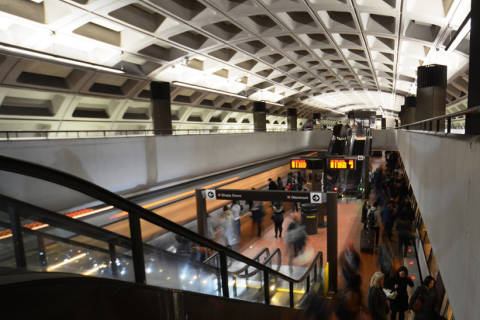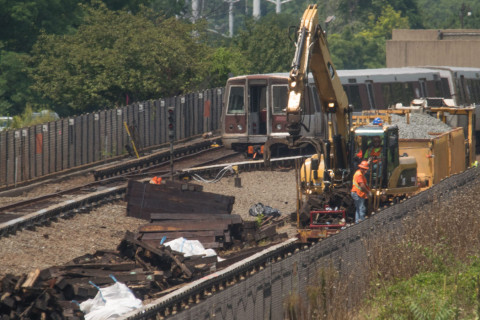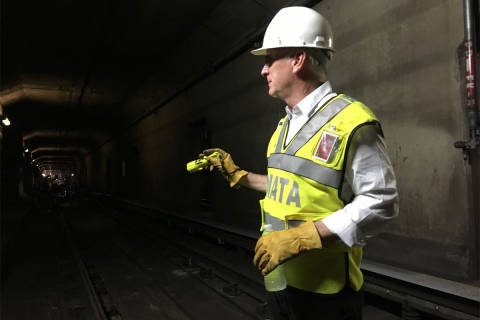WASHINGTON — After federal inspectors were nearly run over by a Metro train in October, the Federal Transit Administration boosted its focus on major problems with Metro’s Rail Operations Control Center and speeding on the rails, according to new documents released by the agency Wednesday.
The inspectors found some significant improvements at the control center, which has been criticized for its lack of coordination. During the deadly Metro smoke incident in January 2015, one controller described the conditions inside the control center as the right hand not knowing what the left hand was doing.
But the inspectors also found Metro has a long way to go.
In an inspection just over a week before the inspectors were nearly struck near Reagan National Airport, the FTA found continued problems with radio communication to and from train operators.
In one case during that inspection, a rail controller tried to reach a train four different times and got no response. The train departed anyway without contacting the controller.
In another, a controller issued an announcement telling trains to slow down near Pentagon City due to a sick passenger, but got no confirmation back from a single train operator that the message was understood.
The control center, which functions as the nerve center of the rail system in the same way air traffic controllers direct traffic at an airport, remains understaffed.
Of 48 budgeted positions, Metro only has 40 people in the control center. The FTA said in October inspection reports that Metro is in the process of hiring three people from outside WMATA and two internal candidates. The total process could take seven months.
Among the key training needs that are not being addressed are tours of the system for controllers so that they can be familiar with the ins and outs of the tracks. Instead, the controllers are needed for duty.
One FTA inspection report said staffing was “generally in compliance” with Metro’s “fatigue-management policy,” but noted there have been instances where controllers worked seven eight-hour shifts per week in part to manage “SafeTrack” repairs.
The FTA did credit Metro before the near-miss with “substantial progress” on some key actions such as improving radio discipline (where radios are working) and better managing unusual train movements or slowdowns.
Separately, track workers are working 12-hour days in 24/7 work zones, sometimes six days per week.
An FTA contractor reviewing Metro’s SafeTrack work said that spending on the track work was over budget as of the end of September, almost exclusively due to about $1 million in overspending on project management costs, according to a report also released Wednesday detailing progress made in September.
That review noted there has been “significant improvement in coordination of work” among different Metro departments. Metro was still developing procedures for identifying and completing work left over from 24/7 work zones.
For example, after Surge 8 near Franconia-Springfield, Metro identified an area that still had 46 deteriorated rail ties.
FTA inspectors noted most work done in Surge 9 on the Orange Line in Virginia appeared to be generally good.
Replacing crumbling rail ties is the main purpose of the surge zones, and Metro says thousands have been replaced in each one.
Managing trains moving through or around the track work is one of the many challenges for the rail traffic controllers, who say they are overwhelmed.
Although a number of the controllers told the FTA that things have improved since May when a new boss took over there, they say they are still often overwhelmed.
Controllers also reported issues with the radio system, including a tendency for channels to bleed into each and drop connection, “which complicate their daily duties,” an FTA summary of interviews with five controllers said.
“Some … felt that the controller has to do all the work, and it can be too much at times,” the Oct. 14 report said.
The desk controlling the Blue, Orange and Silver Line tracks is the busiest, followed by the Red Line’s desk then the Green and Yellow Line’s desk.
Metro is planning to soon split off part of the Orange Line and the Silver Line into a separate desk that could improve safety, because there will be fewer things on each controller’s plate.
The controllers suggested passing off some responsibility for tunnel ventilation fans, the power system and reports of railcar problems to other departments.
Among the FTA’s observations of improvements are a zero-tolerance no-cellphone policy. However, it could be December 2017 or later before Metro meets its staffing goals of 90 percent of the authorized number of controllers on staff.
The end of 2017 is also Metro’s goal for recertifying all of the controllers to new, higher standards. The FTA says Metro must do more to develop a system that checks that controllers are doing their jobs well.
Late next year, Metro hopes to have a plan to cut down on distracting noise in the control center.
While the plan is mainly targeted at feedback from the radio system, an FTA inspector also observed a loud off-topic conversation in the middle of the control center that could have been a distraction for workers.
The near-miss and the slowdowns since near Reagan National
The inspection report filed by the two inspectors who just barely dove out of the way of a speeding train in October does not even mention the incident, however a series of follow-up inspection reports show how seriously the FTA took the incident and how widespread similar issues could be across the Metro system.
The focus of the reviews was on curves or other blind spots in the rail system where watchmen cannot be positioned far enough away from workers to visually notify both trains and the workers far enough ahead of time that the train must slow down an workers must get out of the way.
As Metro said in the weeks after the near-miss near Reagan National, a tree or a train on the opposite track at that location can limit the view, especially at the then-speed limit in the area of 45 mph. In another spot on the Orange Line near Dunn Loring, a short curve provides a similar blind spot that could put workers at risk.
Metro has since lowered the speed limit in that area, even when no workers are present.
On the same day, inspectors on the tracks near Stadium-Armory noted two trains zipped past them too quickly and three trains sped up before the whole train was safely past them.
In the Reagan National incident, the train operator either ignored, forgot or was not aware of the radio announcement of the work zone and did not slow down until after passing the workers.
The following day, FTA inspectors returned to the rail control center and observed proper announcements by Yellow Line controllers of the locations of work zones and speed restrictions. The inspector did notice at least three instances where there was either poor radio communication or a loss of signal. That required some messages to be repeated back and forth two or three times to be sure the message was properly understood.
The FTA directed Metro to address conflicting or confusing information in track protection guides and to focus on identifying each potentially dangerous spot for workers across the system. That is work that Metro expects to take a significant amount of time.
Metro also implemented increased enforcement of speed restrictions near work zones following the incident by assigning a supervisor on stand by at the locations of speed restrictions for workers, and Metro is looking into new technology that could provide a safety backup.
Other issues: Erasing records, missing safety equipment
The near-miss report identified a series of track issues between Reagan National Airport and Braddock Road, an area that was taken out of service for 24/7 work earlier this year. There are areas of crumbling support for the tracks that allow some of the stretches of rails to slide back and forth — a potentially dangerous degree if the issues continued. The FTA ordered extra inspections in the area.
In the Rail Operations Control Center, controllers did not properly sign in and out at a shift change, and an FTA inspector noticed missing or erased signatures on logs that are meant to provide crucial records.
Video feeds to the Rail Operations Control Center on Oct. 11 showed at least three workers boarding a big yellow Metro work vehicle without proper safety equipment.









